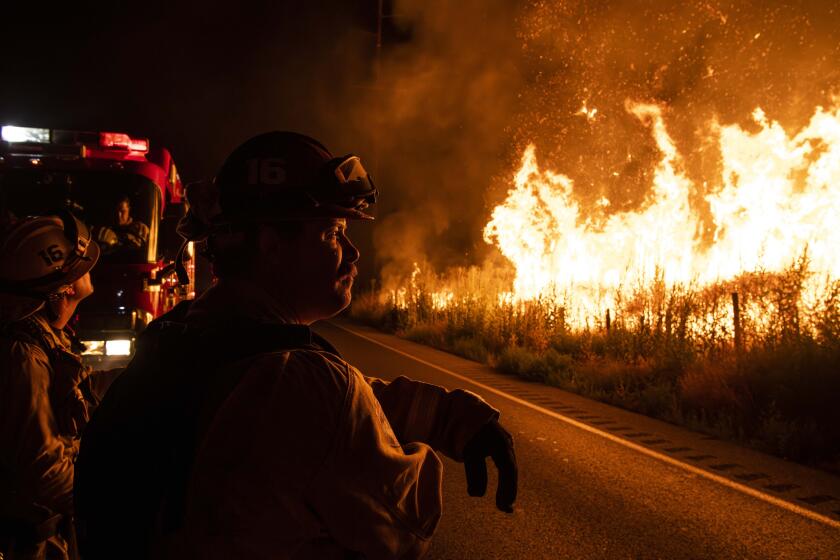L.A.’s History of Self-Imposed Mass Psychosis
- Share via
Has Los Angeles ever before surrendered itself, as it is did before the verdicts in the Rodney G. King civil-rights trial, to an almost dream-like state of self-hypnotized psychosis?
A downtown banker, otherwise the perfect paradigm of bottom-line skepticism, calmly reported that he had inside information that 20,000 gang members--a tight, disciplined army--were prepared to move into the Westside following the verdict in the King civil-rights trial. The city bristled with scores of rumors like this one, most of them catastrophic, most of them in one way or another serving Los Angeles’ deepest, most fearful image of itself: a city at the end of its history.
Government, with the consent of the majority, now occupies the city with local, state and federal forces. To the south, in Camp Pendleton, a battalion of Marines rehearsed for an urban assault, as if Los Angeles were some ungovernable city in Central America, requiring pacification.
On the night and early morning of Feb. 24-25, 1942, Los Angeles experienced a comparable panic in which fears created a similar scenario. On the 24th, a report emanated from mid-level sources in the Western Defense Command, or the Fourth Interceptor Command, that unidentified aircraft had been sighted over the city. At 3:12 a.m. on the 25th, anti-aircraft units of the 37th Coast Artillery Brigade began firing into the darkened sky. Searchlights swept the horizon. When a cease-fire was called at 4:14 a.m., 1,430 shells had been fired at the unidentified intruder. For one hour--sirens wailing, yellow tracer bullets piercing the sky, anti-aircraft ordnance exploding overhead in orange bursts--Los Angeles had its make-believe version, its Hollywood version, of the London Blitz. For the five citizens of L.A. County who died in the blackout--three from traffic accidents, two from heart attacks--the ersatz blitz was all-too real.
Later that year, an L.A. grand jury returned first-degree murder indictments against 19 alleged members of an alleged 38th Street gang for the alleged murder of Jose Diaz. On the morning of Aug. 2, the victim was found beaten and unconscious near an abandoned gravel pit and swimming hole on the Williams Ranch in East Los Angeles, where young Mexican-Americans liked to hang out. The press dubbed the site Sleepy Lagoon after a popular song of the time, and the affair--the indictment of the young men strictly on the ground that they had attended the same party as Diaz, the alleged clash of Mexican gangs, the suggestion of sexual activity at the Sleepy Lagoon--spoke perfectly to Los Angeles’ collective fear of its Mexican-American youth.
In early June, 1943, Los Angeles once again went into a state of psychosis, surrendering itself to the dream-fear that Mexican-American pachucos wearing zoot suits constituted a major threat to the security not only of the city but of the entire country. In all three situations--the bogus blitz, the Sleepy Lagoons indictments, the Zoot-Suit Riots--Los Angeles reacted much like it has to the King civil-rights trial.
First, there was a basis in fact: The Japanese did bomb Pearl Harbor; someone did kill Diaz; a few zoot-suiters did get into fights over girls with servicemen. But in each case, Los Angeles seized upon the real problems and transmogrified them by ballooning its fears into an imagined apocalypse, which the city proceeded to treat as fact.
Why does Los Angeles do this? Why was surrendering its sovereignty as a self-governing city, mobilizing itself into an occupied war zone that became, sadly, outside the psychological boundaries of the United States? Not since the Draft Riots in New York, in 1863, or the segregation resistance in Little Rock, Ark., in 1957, had a U.S. city been put into such a dramatic state of Chapter 11 as Los Angeles had so willingly done to itself these past few weeks.
Was it necessary? Or did the pre-verdict mood representd yet another surrender to collective dream-psychosis on the part of a city in which fantasy, even fantasy noir, holds a special seduction?
Future historians will look back to these days and struggle to interpret a time in which fear became fact and rumor became the basis of policy. A bad situation, in other words, was collectively dreamed-wished into something even worse: a vision of Los Angeles as Beirut. Sadly, the dream was so strong, so compelling--so speaking to the fear of others, to guilt over vast polarities of wealth, to crime and misbehavior and rioting that intensified an already exiting distrust of shared civic life--it became its own horrible reality, and the City of the Angels, as it always feared it would, dreamt itself out of existence.
More to Read
Sign up for Essential California
The most important California stories and recommendations in your inbox every morning.
You may occasionally receive promotional content from the Los Angeles Times.










